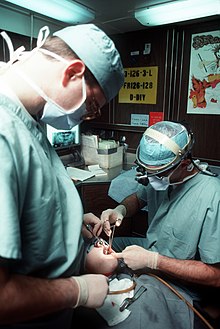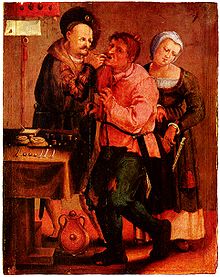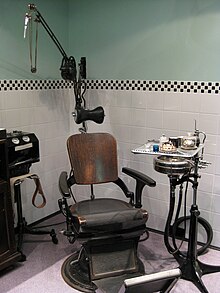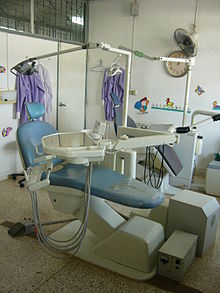| Revision as of 23:39, 20 March 2009 edit98.166.139.216 (talk) →External links: {{wiktionary}}{{commonscat}}← Previous edit | Revision as of 15:36, 21 March 2009 edit undoFences and windows (talk | contribs)Autopatrolled, Administrators50,406 edits →History: Adding note about quackery in the history of dentistryNext edit → | ||
| Line 73: | Line 73: | ||
| The first book focused solely on dentistry was the "Artzney Buchlein" in 1530,<ref></ref> and the first dental textbook written in English was called "Operator for the Teeth" by Charles Allen in 1685.<ref name="bdatimeline">, hosted on the British Dental Association website. Page accessed 11 December 2007.</ref> It was between 1650 and 1800 that the science of modern dentistry developed. It is said that the 17th century French physician ] started dentistry science as we know it today, and he has been named ''"the father of modern dentistry"''.<ref></ref> Among many of his developments were the extensive use of ], the introduction of ] as a treatment for ] and the statement that sugar derivate acids such as ] are responsible for dental decay. | The first book focused solely on dentistry was the "Artzney Buchlein" in 1530,<ref></ref> and the first dental textbook written in English was called "Operator for the Teeth" by Charles Allen in 1685.<ref name="bdatimeline">, hosted on the British Dental Association website. Page accessed 11 December 2007.</ref> It was between 1650 and 1800 that the science of modern dentistry developed. It is said that the 17th century French physician ] started dentistry science as we know it today, and he has been named ''"the father of modern dentistry"''.<ref></ref> Among many of his developments were the extensive use of ], the introduction of ] as a treatment for ] and the statement that sugar derivate acids such as ] are responsible for dental decay. | ||
| There has been a problem of ] in the history of dentistry, and accusations of quackery among some dental practitioners persist today.<ref>{{cite journal|last=Ring|first=Malvin E|date=1998|title=Quackery in Dentistry -- Past and Present|journal=Journal of the California Dental Association|url=http://www.cda.org/library/cda_member/pubs/journal/jour1198/quackery.html|accessdate=21 March 2009}}</ref> | |||
| ]. Typical of dental surgeries, civil and military, during the 1940s and 1950s.]] | ]. Typical of dental surgeries, civil and military, during the 1940s and 1950s.]] | ||
Revision as of 15:36, 21 March 2009
This article is about the dental profession. For tooth care see oral hygiene dental surgery.

Dentistry is the known evaluation, diagnosis, prevention, and treatment of diseases, disorders and conditions of the oral cavity, maxillofacial area and the adjacent and associated structures and their impact on the human body. Dentistry is widely considered necessary for complete oral health. Those in the practice of dentistry are known as dentists. Other people aiding in oral health service include dental assistants, dental hygienists, dental technicians, and dental therapists.
Dentistry is that branch of science which deals with the study and practice of diagnosis, prevention, and treatment of diseases of the mouth, the maxilla, and the face.
Complete
Surgery
Dentistry usually encompasses very important practices related to the oral cavity. The most common treatments involve the dental surgery on the teeth as a treatment for dental caries. Decayed teeth can be filled with dental amalgam, dental composite, dental porcelain and precious or non-precious metals. Oral and maxillofacial surgery is a more specialized form of dental surgery. Dentists can prescribe medication, x-rays, and devices for home or in-office use. Many oral diseases (such as bilateral odontogenic keratocysts) and abnormalities (such as several unerupted teeth) can indicate systemic, neural, or other diseases. Most general practitioners of dentistry perform restorative, prosthetic, endodontic therapy, periodontal therapy, and exodontia, as well as performing examinations. Many general practitioners are comfortable treating complex cases, as well as placing implants and surgically extracting third molars (wisdom teeth). All dentists must achieve a certain degree of skill in various disciplines in order to graduate from dental school and become an accredited dentist.
Prevention
Dentists also encourage prevention of dental caries through proper hygiene (tooth brushing and flossing), fluoride, and tooth polishing. Dental sealants are plastic materials applied to one or more teeth, for the intended purpose of preventing dental caries or other forms of tooth decay. Recognized but less conventional preventive agents include xylitol, which is bacteriostatic, casein derivatives, and proprietary products such as Cavistat BasicMints.
Education and licensing
The Baltimore College of Dental Surgery, the first dental school in the world, opened in Baltimore, Maryland in 1840, and in 1867, Harvard Dental School became the second dental school affiliated with a university.
Studies showed that dentists graduated from different countries, or even from different dental schools in one country, may have different clinical decisions for the same clinical condition. For example, dentists graduated from Israeli dental schools may recommend more often for the removal of asymptomatic impacted third molar (wisdom teeth) than dentists graduated from Latin-American or Eastern European dental schools.
In England, the 1878 British Dentists Act and 1879 Dentists Register limited the title of "dentist" and "dental surgeon" to qualified and registered practitioners. The practice of dentistry in the United Kingdom became fully regulated with the 1921 Dentists Act, which required the registration of anyone practicing dentistry. The British Dental Association, formed in 1880 with Sir John Tomes as president, played a major role in prosecuting dentists practicing illegally. A dentist is a healthcare professional qualified to practice dentistry after graduating with a degree of either Doctor of Dental Surgery (DDS), Doctor of Dental Medicine (DMD), Bachelor of Dentistry (BDent), Bachelor of Dental Science (BDSc), or Bachelor of Dental Surgery/Chirurgiae (BDS) or (BChD) or equivalent. In most western countries, to become a qualified dentist one must usually complete at least 4 years of postgraduate study; within the European Union the education has to be at least 5 years. Dentists usually complete between 5–8 years of post secondary education before practicing. Though not mandatory, many dentists choose to complete an internship or residency focusing on specific aspects of dental care after they have received their dental degree.
Specialities
In addition to general dentistry, there are about 9 recognized dental specialties in the US, Canada, and Australia. To become a specialist requires one to train in a residency or advanced graduate training program. Once residency is completed, the doctor is granted a certificate of specialty training. Many specialty programs have optional or required advanced degrees such as a masters degree: (MS, MSc, MDS, MSD, MDSc, MMSc, or MDent), doctoral degree: (DClinDent, DMSc, or PhD), or medical degree: (MD/MBBS specific to Maxillofacial Surgery and sometimes Oral Medicine).
- Dental public health (study of dental epidemiology and social health policies),
- Endodontics (root canal therapy and study of diseases of the dental pulp),
- Oral and Maxillofacial Pathology (study, diagnosis, and sometimes the treatment of oral and maxillofacial related diseases),
- Oral and Maxillofacial Radiology (study and radiologic interpretation of oral and maxillofacial diseases),
- Oral and Maxillofacial Surgery (extractions, implants, and facial surgery),
- Orthodontics and Dentofacial Orthopaedics (straightening of teeth and modification of midface and mandibular growth),
- Periodontics (study and treatment of diseases of the periodontium (non-surgical and surgical), and placement and maintenance of dental implants),
- Pediatric dentistry (i.e. dentistry for children, formerly known as "pedodontics"),
- Prosthodontics (dentures, bridges and the restoration of implants. Some prosthodontists further their training in "oral and maxillofacial prosthodontics"--a discipline concerned with the replacement of missing facial structures--such as ears, eyes, nose, etc.)
Specialists in these fields are designated registrable (U.S. "Board Eligible") and warrant exclusive titles such as orthodontist, oral and maxillofacial surgeon, endodontist, pediatric dentist, periodontist, or prosthodontist upon satisfying certain local (U.S. "Board Certified"), (Australia/NZ: "FRACDS"), or (Canada: "FRCD(C)") registry requirements.
A tenth specialty, dental anesthesiology, the study of how to relieve pain through advanced use of local and general anesthesia techniques is not yet considered to be one of the recognized dental specialties. However, CODA is in the process of accrediting all dental anesthesiology programs.
An eleventh specialty, Special needs dentistry is dentistry for those with developmental and acquired disabilities. It is a recognized specialty by the Royal Australasian College of Dental Surgeons. It has also been recently recognised as a specialty by the General Dental Council in the United Kingdom. The American Board of Special Care Dentistry is hoping to also obtain accreditation for special needs dentistry by CODA.,
A few other post-graduate formal advanced education programs: GPR, GDR, MTP residencies (advanced clinical and didactic training with intense hospital experience) and AEGD, SEGD, and GradDipClinDent programs (advanced training in clinical dentistry) are recognized but do not lead to specialization.
The American Board of Dental Sleep Medicine (ABDSM) provides board-certification examinations annually for qualified dentists. These dentists collaborate with sleep physicians at accredited sleep centers and can provide oral appliance therapy and upper airway surgery to treat sleep-related breathing disorders. While Diplomate status granted by the ABDSM is not one of the recognized dental specialties, it is recognized by the American Academy of Sleep Medicine (AASM).
Special category: Oral Biology - Research in Dental and Craniofacial Biology
Other dental education exists where no postgraduate formal university training is required: cosmetic dentistry, dental implant, temporo-mandibular joint therapy. These usually require the attendance of one or more continuing education courses that typically last for one to several days. There are restrictions on allowing these dentists to call themselves specialists in these fields. The specialist titles are registrable titles and controlled by the local dental licensing bodies.
Forensic odontology consists of the gathering and use of dental evidence in law. This may be performed by any dentist with experience or training in this field. The function of the forensic dentist is primarily documentation and verification of identity.
Geriatric dentistry or geriodontics is the delivery of dental care to older adults involving the diagnosis, prevention, and treatment of problems associated with normal ageing and age-related diseases as part of an interdisciplinary team with other health care professionals.
Veterinary dentistry, a speciality of veterinary medicine, is the field of dentistry applied to the care of animals.
Aviation dentistry, a subcategory of (military) aviation medicine deals with dental topics related to aircrews, e.g., dental barotrauma and barodontalgia. In addition, the aircrew population is a unique high-risk group to several diseases and harmful conditions due to irregular work shifts with irregular self-oral care habits and irregular meals (usually carbonated drinks and high energy snacks) and work-related stress.
History

The Indus Valley Civilization has yielded evidence of dentistry being practiced as far back as 7000 BCE. This earliest form of dentistry involved curing tooth related disorders with bow drills operated, perhaps, by skilled bead craftsmen. The reconstruction of this ancient form of dentistry showed that the methods used were reliable and effective.
A Sumerian text from 5000 BC describes a "tooth worm" as the cause of dental caries. Evidence of this belief has also been found in ancient India, Egypt, Japan, and China. The legend of the worm is also found in the writings of Homer, and as late as the 1300s AD the surgeon Guy de Chauliac still promoted the belief that worms cause tooth decay.
The Edwin Smith Papyrus, written in the 17th century BC but which may reflect previous manuscripts from as early as 3000 BC, includes the treatment of several dental ailments. In the 18th century BC, the Code of Hammurabi referenced dental extraction twice as it related to punishment. Examination of the remains of some ancient Egyptians and Greco-Romans reveals early attempts at dental prosthetics and surgery.
Ancient Greek scholars Hippocrates and Aristotle wrote about dentistry, including the eruption pattern of teeth, treating decayed teeth and gum disease, extracting teeth with forceps, and using wires to stabilize loose teeth and fractured jaws. The first use of dental appliances or bridges comes from the Etruscans from as early as 700 BC. Roman medical writer Cornelius Celsus wrote extensively of oral diseases as well as dental treatments such as narcotic-containing emollients and astringents.

Historically, dental extractions have been used to treat a variety of illnesses. During the Middle Ages and throughout the 19th century, dentistry was not a profession in itself, and often dental procedures were performed by barbers or general physicians. Barbers usually limited their practice to extracting teeth which alleviated pain and associated chronic tooth infection. Instruments used for dental extractions date back several centuries. In the 14th century, Guy de Chauliac invented the dental pelican (resembling a pelican's beak) which was used up until the late 18th century. The pelican was replaced by the dental key which, in turn, was replaced by modern forceps in the 20th century.
The first book focused solely on dentistry was the "Artzney Buchlein" in 1530, and the first dental textbook written in English was called "Operator for the Teeth" by Charles Allen in 1685. It was between 1650 and 1800 that the science of modern dentistry developed. It is said that the 17th century French physician Pierre Fauchard started dentistry science as we know it today, and he has been named "the father of modern dentistry". Among many of his developments were the extensive use of dental prosthesis, the introduction of dental fillings as a treatment for dental caries and the statement that sugar derivate acids such as tartaric acid are responsible for dental decay.
There has been a problem of quackery in the history of dentistry, and accusations of quackery among some dental practitioners persist today.


Priority patients
| This section may contain information not important or relevant to the article's subject. Please help improve this section. (Learn how and when to remove this message) |
UK NHS priority patients include patients with congenital abnormalities (such as cleft palate and hypodontia), patients who have suffered orofacial trauma and those being treated for cancer in the head and neck region. These are treated in a multidisciplinary team approach with other hospital based dental specialties orthodontics and maxillofacial surgery. Other priority patients include those with infections (either third molars or necrotic teeth which can often infect the brain) or avulsed permanent teeth.
Patients with a history of smoking or smokeless tobacco with ulcers in the oral cavity are also considered high risk/priority patients.
Geography
Main article: Dentistry throughout the worldOrganizations
Main article: List of dental organizationsSee also

- Barodontalgia
- Biodontics
- Calculus
- Crown
- Dental amalgam
- Dental brace
- Dental cavities
- Dental extraction
- Dental fear
- Floss
- Dental implants
- Dental notation
- Dental restoration
- Dental spa
- Dentin
- Fluoridation
- Fluoride therapy
- Gingivitis
- Halitosis
- Laboratory technology
- Mouthwash
- Nitrous oxide
- Novocain, a Local anesthetic
- Occlusion
- Occupational Safety and Health Administration
- Oral and maxillofacial surgery
- Oral hygiene
- Orthodontics
- Patron Saint of dentistry (Saint Apollonia)
- Periodontitis
- Periodontology or Periodontics
- Plaque
- Teledentistry
- Toothache
- Toothbrush
- Toothpaste
- Xerostomia
Lists
- List of dentists
- List of oral health and dental topics
- List of basic dentistry topics
- List of dental schools in the United States
References
- Dentistry Definitions, hosted on the American Dental Association website. Page accessed 11 December 2007. This definition was adopted the association's House of Delegates in 1997.
- American Academy of Pediatric Dentistry. (2006) Policy on the Use of Xylitol in Caries Prevention.
- Azarpazhooh, A.; Limeback, H. (2008), "Clinical Efficacy of Casein Derivatives: A Systematic Review of the Literature", The Journal of the American Dental Association, 139 (7), Am Dental Assoc: 915, PMID 18594077
{{citation}}: Unknown parameter|day=ignored (help); Unknown parameter|month=ignored (help)CS1 maint: multiple names: authors list (link) - Experimental chewy mint beats tooth decay
- Zadik Yehuda, Levin Liran (2008). "Clinical decision making in restorative dentistry, endodontics, and antibiotic prescription". J Dent Educ. 72 (1): 81–6. PMID 18172239.
{{cite journal}}:|access-date=requires|url=(help); Unknown parameter|month=ignored (help) - Zadik Yehuda, Levin Liran (2006). "Decision making of Hebrew University and Tel Aviv University Dental Schools graduates in every day dentistry--is there a difference?". J Isr Dent Assoc. 23 (2): 19–23. PMID 16886872.
{{cite journal}}:|access-date=requires|url=(help); Unknown parameter|month=ignored (help). - Zadik Yehuda, Levin Liran (2007). "Decision making of Israeli, East European, and South American dental school graduates in third molar surgery: is there a difference?". J Oral Maxillofac Surg. 65 (4): 658–62. doi:10.1016/j.joms.2006.09.002. PMID 17368360. Retrieved 2008-07-16.
{{cite journal}}: Unknown parameter|month=ignored (help) - ^ Gelbier, Stanley. 125 Years of Developments in Dentistry. British Dental Journal (2005); 199, 470-473. Page accessed 11 December 2007. The 1879 register is referred to as the "Dental Register". Cite error: The named reference "125years" was defined multiple times with different content (see the help page).
- ^ The story of dentistry: Dental History Timeline, hosted on the British Dental Association website. Page accessed 11 December 2007.
- History of Dental Surgery in Edinburgh, hosted on the Royal College of Surgeons of Edinburgh website. Page accessed 11 December 2007.
- AVDC Home
- EVDC web site
- Zadik Y (2006). "Dental Fractures on Acute Exposure to High Altitude". Aviat Space Environ Med. 77 (6): 654–7. PMID 16780246. Retrieved 2008-07-16.
{{cite journal}}: Unknown parameter|month=ignored (help) - Zadik Y (2006). "Barodontalgia due to odontogenic inflammation in the jawbone". Aviat Space Environ Med. 77 (8): 864–6. PMID 16909883. Retrieved 2008-07-16.
{{cite journal}}: Unknown parameter|month=ignored (help) - Zadik Y, Chapnik L, Goldstein L (2007). "In-flight barodontalgia: analysis of 29 cases in military aircrew". Aviat Space Environ Med. 78 (6): 593–6. PMID 17571660. Retrieved 2008-07-16.
{{cite journal}}: Unknown parameter|month=ignored (help)CS1 maint: multiple names: authors list (link) - Lurie, Orit; Zadik, Yehuda; Tarrasch, Ricardo; Raviv, Gil; Goldstein, Liav (2007). "Bruxism in Military Pilots and Non-Pilots: Tooth Wear and Psychological Stress". Aviat Space Environ Med. 78 (2): 137–9. PMID 17310886. Retrieved 2008-07-16.
{{cite journal}}: Unknown parameter|month=ignored (help)CS1 maint: multiple names: authors list (link) - Coppa, A. et al. 2006. Early Neolithic tradition of dentistry. Nature. Volume 440. 6 April, 2006.
- BBC (2006). Stone age man used dentist drill.
- MSNBC (2008). Dig uncovers ancient roots of dentistry.
- History of Dentistry: Ancient Origins, hosted on the American Dental Association website. Page accessed 9 January 2007.
- Suddick, Richard P. and Norman O. Harris. "Historical Perspectives of Oral Biology: A Series". Critical Reviews in Oral Biology and Medicine, 1(2), pages 135-151, 1990.
- Arab, M. Sameh. Medicine in Ancient Egypt. Page accessed 15 December 2007.
- Ancient Egyptian Dentistry, hosted on the University of Oklahoma website. Page accessed 15 December 2007.
- Wilwerding, Terry. History of Dentistry, hosted on the Creighton University School of Dentistry website, page 4. Page accessed 15 December 2007.
- Medicine in Ancient Egypt 3
- History of Dentistry Ancient Origins
- History of Dentistry Research Page, Newsletter
- Dentistry - Skill And Superstition
- Dental Treatment in the Ancient Times
- ^ Antique Dental Instruments
- History of Dentistry Middle Ages
- History of Dentistry Articles
- Ring, Malvin E (1998). "Quackery in Dentistry -- Past and Present". Journal of the California Dental Association. Retrieved 21 March 2009.
External links
- Communication and information in orthodontics
- History of Dentistry in the 20th Century by the ADA
- Information resource for UK dental professionals
- Ancient dentistry discovered
- Dentpedia.info - Dental Encyclopedia
- Template:Dmoz
| Cleft lip and cleft palate | |
|---|---|
| Related specialities | |
| Related syndromes | |
| National and international organisations | |